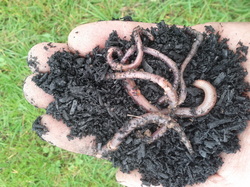OLD TECHNOLOGY NEW SCIENCE

In its most basic terms Biochar is simply virgin charcoal* that is added to the soil as a soil improver. As it is inert and non-decomposable it can remain in the soil for hundreds of years and thus acts as a carbon store in the soil. For this reason, currently, there is huge interest in it by the scientific and agricultural communities.
*Never use charcoal purchased in shops as a soil amendment unless you are sure no ignition fuel has been added to it.
*Never use charcoal purchased in shops as a soil amendment unless you are sure no ignition fuel has been added to it.
HistoryThere is evidence of the benefits of Biochar from across the globe. Probably the oldest recorded description of Biochar use in agriculture comes from Japan. In 1697 “fire manure” was prepared by roasting organic wastes and mixing them with nutrient rich manures. Rice husk Biochar has been used for several thousand of years, since the beginning of rice cultivation in Asia. As a result of these experience and research, carbonized materials are formally authorized for use as soil amendment material in Japan, which is using 27% of its national charcoal production for purposes other than fuel, more than 30% of which is used in agriculture.
|
Further evidence of the historical use of Biochar is outlined in ‘A History of Irish Farming, 1750-1950’ where the process of ‘Pairing and Burning’ to enrich soils is described in Ireland at the same time as it was occurring in Japan. Here the surface sod of the land was stripped, allowed to dry, then heaped and burdened and the subsequent ashes spread on the land as a fertilizer. The results of this practice are still evident around the countryside today if you know where to look. Indeed this practice of burning mountain land may very well be akin to the burning of scrub land in Australia where it is widely accepted that burning releases nutrients into poor blanket peats. In fact the burning of bush by the native tribes of Australia for millennia has led to Australian being one of the leaders in Biochar research.
|
More recently, interest in Biochar has been renewed following the discovery by scientists of ‘Terra Preta’ soils in the Amazon basin. These soils were found to contain large quantities of charcoal and importantly, they produced crops which had far greater yields than neighbouring soils without charcoal. Indeed so widely accepted is this, that it is possible to buy Terra Preta soil in some parts of Brazil.
|
